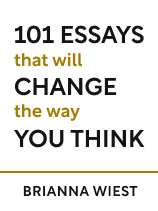

This article is an excerpt from the Shortform book guide to "101 Essays That Will Change the Way You Think" by Brianna Wiest. Shortform has the world's best summaries and analyses of books you should be reading.
Like this article? Sign up for a free trial here .
What does it mean to “be true to yourself”? What does staying true to yourself entail in practice?
People inherit values and beliefs about the world from their family and society at large—this is a natural part of socialization. The problem is that some people never question these values, beliefs, and ideals, even if they are in stark opposition to what feels right to them. Though social conditioning is pervasive, you can overcome it, learn to think for yourself, and feel better about yourself and your experiences.
With that in mind, here’s how to stay true to yourself.
Focus on Your Feelings to Define Your Needs
In her book 101 Essays That Will Change the Way You Think, Brianna Wiest explains how to stay true to yourself and your feelings. According to Wiest, being true to yourself requires that you first get to know yourself. This involves paying constant attention to how you feel so that you can discover who you are and what you need to feel happy. Wiest explains that the more aware you are of your feelings, the easier you find it to challenge and replace the thoughts and behaviors that contribute to your unwanted feelings.
How can you develop an awareness of how your thoughts create your feelings? Wiest suggests that being mindful will help you to shift your focus from the external (other people, your circumstances) to the internal (your feelings). This, in turn, will help you separate how you feel about yourself from how you imagine other people think about you. As a result, you’ll be able to think more clearly about what’s important to you and what you need to feel happy.
(Shortform note: Mental health practitioners confirm that practicing mindfulness increases self-awareness, encourages positive thoughts about yourself, your circumstances, and others, and improves your mental well-being. In Mindfulness in Plain English, Bhante Gunaratana recommends establishing a schedule to turn your mindfulness practice into a habit. Begin by setting aside 10 to 20 minutes each morning or evening to practice quieting your mind, lengthening your time as you get more comfortable with the process.)
Assess Your Current Opinions and Beliefs
According to Wiest, an important step in staying true to yourself is assessing whether your current opinions and beliefs align with who you really are, or if they only exist to please or impress others. She suggests that you can dissect each of your opinions and beliefs by asking yourself the following four questions:
- When was the first time you came across this idea? For example, you believe that people should not make mistakes. You remember overhearing your parents punishing one of your siblings for making errors on a spelling test.
- How does this idea influence your judgment of yourself, other people, and your experiences? Your belief that people should not make mistakes compels you to be overly critical of yourself and others. It also makes you feel resentful of the experiences that don’t live up to your perfect standards.
- How might adopting opposing ideas impact you? If instead, you choose to believe that it’s okay to make mistakes, you might find it easier to accept and forgive yourself and others for making mistakes. You might also be less inclined to notice mistakes in the first place.
- How would you choose to think about this if your thoughts were already aligned with who you really are? Your aligned self sees mistakes as a valuable part of learning. Therefore, there’s no need to feel critical of yourself or others for making mistakes.
Explore Your Judgments to Identify Your Suppressed Feelings
In addition to exploring your opinions and beliefs, Wiest suggests that you should specifically explore your judgments about other people to identify your suppressed feelings. According to her, every negative feeling you have about someone else is simply a projection of the aspects of yourself that you dislike or feel ashamed of. Therefore, she suggests that you consider all of the things that you dislike about other people to uncover what parts of yourself you’ve been conditioned to believe are “wrong” or “bad.”
This exercise will reveal how you’re currently modifying your behaviors to please or impress others. It will also help you to accept and express the parts of yourself that you’ve been too ashamed to expose to others.
- For example, you despise your colleague at work because she constantly interrupts you while you’re busy. Exploring deeper, you realize that you dislike her because you view her interruptions as a ploy for attention. Seeking attention is something you avoid doing because you’ve been conditioned to see this as “wrong.”

———End of Preview———
Like what you just read? Read the rest of the world's best book summary and analysis of Brianna Wiest's "101 Essays That Will Change the Way You Think" at Shortform .
Here's what you'll find in our full 101 Essays That Will Change the Way You Think summary :
- Why the only way to make yourself feel better is to change the way you think
- How social conditioning influences the way you unconsciously think
- How to manage your thoughts and feelings about yourself and your experiences






